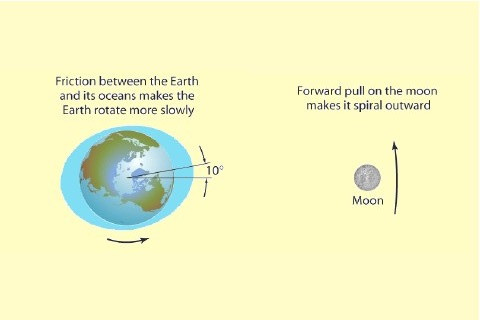Skip to main content Moon Tides and Tidal Evolution
- Moon’s gravity — an attractive force on Earth’s oceans, causes them to rise and fall over the course of a day
- Why 2 high tides per day?
- Moon exerts a stronger force on near side of Earth, less at center, and even less on the far side
- Relative to center of Earth, the effective forces pull water on Earth both toward and away from Moon
- Leads to 2 bulges of water on Earth’s surface — and 2 high tides per day
- Similarly, Earth’s gravity exhibits a tidal force on Moon’s solid structure (much stronger than Moon’s influence on Earth)
- Tidal forces slowed down Moon’s rotation over millions of years, causing it to always keep the same surface pointing towards Earth
- The equality of the Moon’s rotation and revolution periods is not a coincidence
- Because Earth is rotating, the Earth’s tidal budge does not point exactly at moon, it points about 10 degrees ahead of the Moon’s position
- Moon’s gravity luges back on the bulge which slowly causes Earth’s rotation rate to slow
- Similarly, gravity of the bulge tugs the Moon forward — slowly causing the Moon to accelerate in its orbit
- Because of this, the length of the day and the month are slowly increasing and the Moon is slowly receding from the Earth
- hundreds of millions of years from now, the Earth and Moon will both be “tide locked” to each other
- Earth will rotate at exactly the same rate that the Moon orbits
- The Earth will always keep the same face towards the Moon just as the Moon always keeps the same face towards the Earth
- We see other examples of tidal locking in other pairs of objects in the solar system



